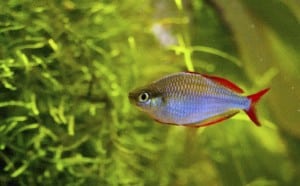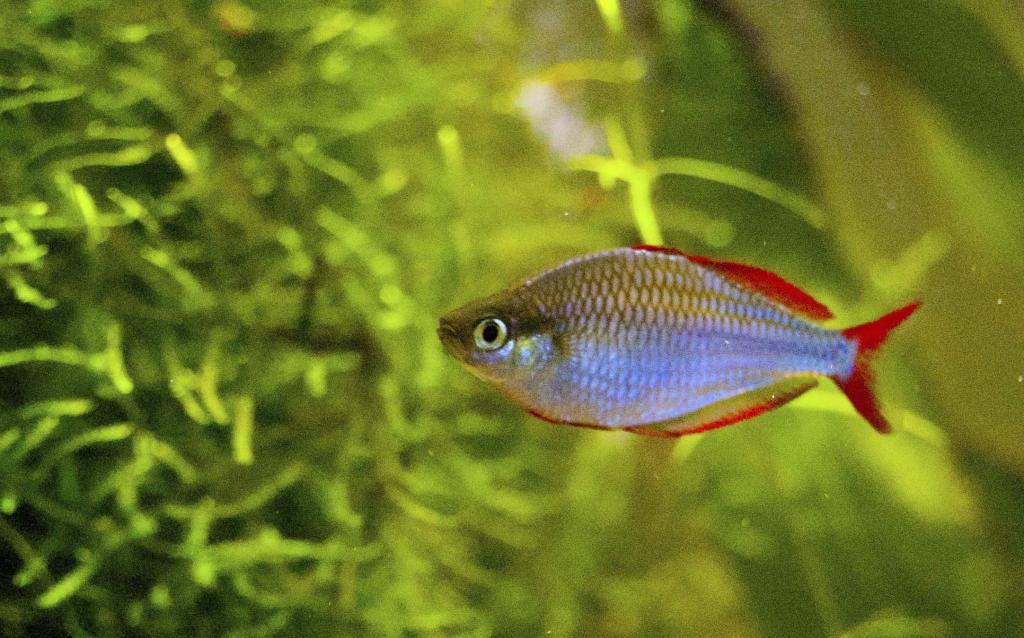
Common name: Praecox Rainbowfish, Dwarf Neon Rainbowfish
Scientific name: Melanotaenia Praecox
Average Adult Fish Size: 3 inches / 8 cm
Place of Origin: Indonesia
Typical Tank setup: Praecox Rainbows are a very popular aquarium fish, and don’t require anything special. A peaceful community aquarium. Rainbows would ideally be in a planted tank. When housing Praecox Rainbow’s in the home aquarium it is important to provide them with a long (4 feet or larger) aquarium that has areas of plants and plenty of room for these active swimmers to move about. They are also well known jumpers, thus their aquarium should be well covered in order to keep them from jumping out of the aquarium when startled.
Recommended Minimum Aquarium Capacity: 55 gallon / 240 litre
Compatibility: Peaceful community tank mates like Molly’s, Guppies, Plat’s and Tetra’s.
Temperature: 23 – 32 Deg C / 73 – 89 Deg F
Water chemistry: pH 4.5 – 7.5
Feeding: The Praecox Rainbowfish should be fed once or twice a day. It is very important not to over-feed your Rainbow. All food should be consumed after just a few minutes. If not, you are feeding your Rainbow to much food in one serving. You can buy flake food specially made for tropical fish, such as the Rainbow in your fish store. A flake food diet is a good base for the Rainbow, but should ideally be supplemented with live food. Your Rainbow will survive on flake food alone, but the live food makes the Rainbow more well-nourished and healthier. Live or frozen Brine Shrimp is a popular Rainbow fish food since Brine Shrimp is very easy to produce at home. Bloodworms, Micro Worms, Fruit Flies, Mosquito larvae, Daphnia and chopped up Earthworms are other examples of suitable food for your Rainbow.
Sexing: Males have red fins while females have yellow to light orange fins. The males breeding stripe from top of nose to dorsal fin flashes yellow during displays.
Breeding: Rainbow’s deposits its eggs in vegetation or other suitable substrate with Java moss. It’s best spawned in a pair or group comprising a single male and two or three females in a tank measuring 50-60 cm long.
Females are capable of covering some large, vigorous eggs per day and the adults can either be added to the spawning tank and left in place for a week or so, until the first fry are noticed, or the substrate can be checked each day and eggs removed manually. Males can be aggressive in their pursuit of females keep a look out when on the fish while they’re housed in these confined surroundings, and try to provide some solid cover using large-leaved plants or wood.
Additional Information: These fish are undoubtedly one of the most popular in the hobby. Many fish stores recommend these fish as suitable for first time fish owners. They are easy to look after, but will usually struggle with a cycling tank, and would probably die, so they should not be added to a tank until the cycle has been completed.


Related Posts
Croaking Gourami – Trichopsis vittatus
Benthochromis Tricoti
Large-eyed Mouthbrooder – Callochromis Macrops